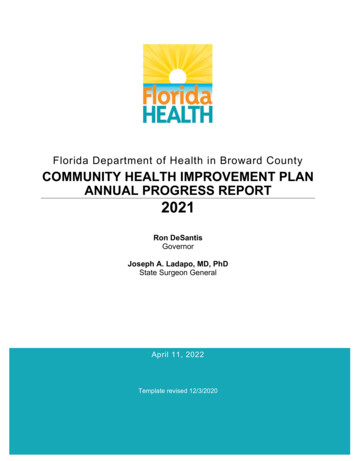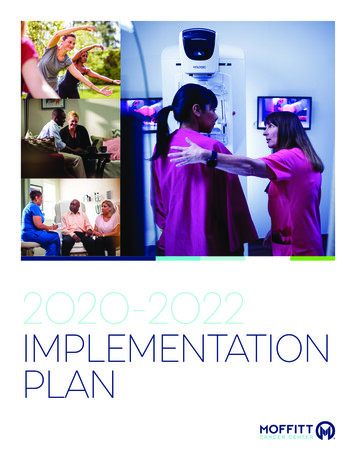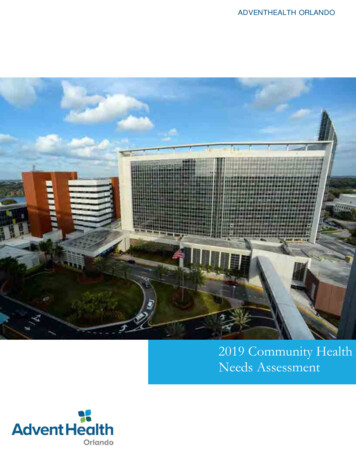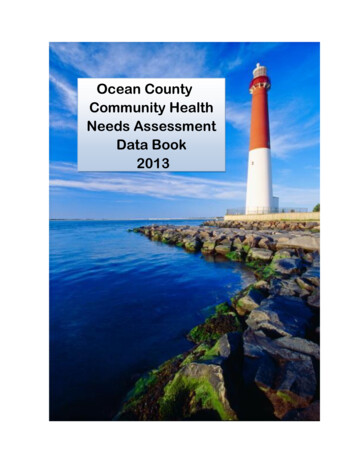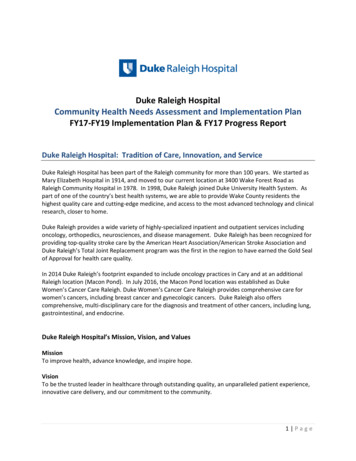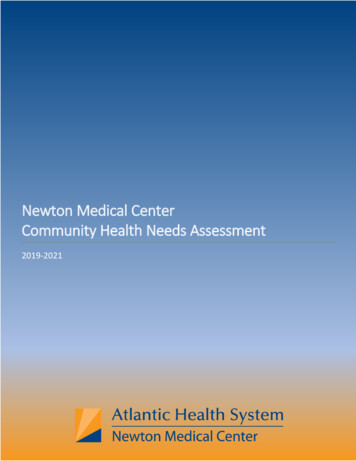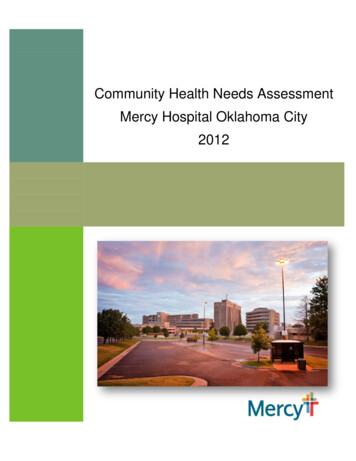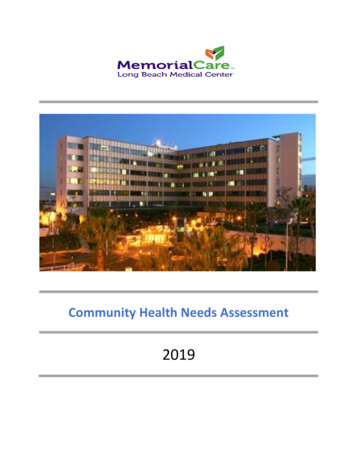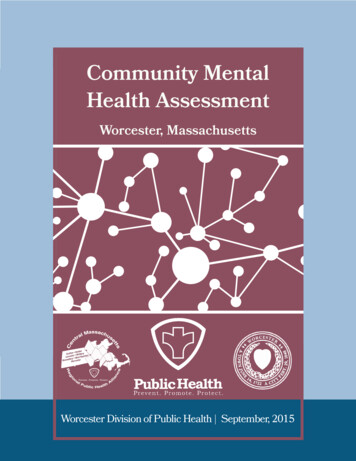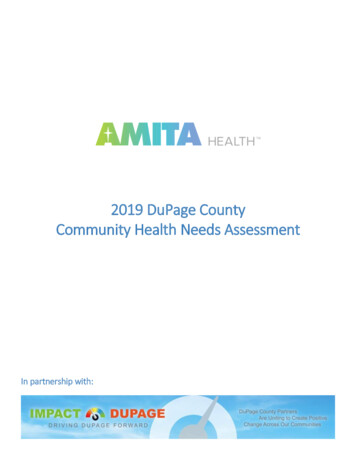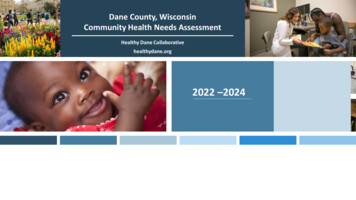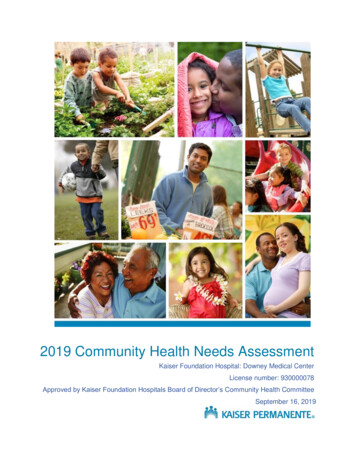
Transcription
2019 Community Health Needs AssessmentKaiser Foundation Hospital: Downey Medical CenterLicense number: 930000078Approved by Kaiser Foundation Hospitals Board of Director’s Community Health CommitteeSeptember 16, 2019
Kaiser Permanente Southern California Region Community BenefitCHNA Report for KFH-DowneyContentsI. Introduction/backgroundA. About Kaiser Permanente (KP)B. About Kaiser Permanente Community HealthC. Purpose of the Community Health Needs Assessment (CHNA) ReportD. Kaiser Permanente’s approach to Community Health Needs Assessment44455II. Community servedA. Kaiser Permanente’s definition of community servedB. Map and description of community servedi. Mapii. Geographic description of the community servediii. Demographic profile of the community servediv. Severely under-resourced communities6677788III. Who was involved in the assessment?9A. Identity of hospitals and other partner organizations that collaborated on the assessment9B. Identity and qualifications of consultants used to conduct the assessment10IV. Process and methods used to conduct the CHNAA. Secondary datai. Sources and dates of secondary data used in the assessmentii. Methodology for collection, interpretation, and analysis of secondary dataB. Community inputi. Description of who was consultedii. Methodology for collection and interpretationC. Written commentsD. Data limitations and information gaps101010111415161616V. Identification and prioritization of the community’s health needsA. Identifying community health needsi. Definition of “health need”ii. Criteria and analytical methods used to identify the community health needsB. Process and criteria used for prioritization of health needsC. Prioritized description of all the community needs identified through the CHNAD. Community resources potentially available to respond to the identified health needs17171717171819VI. KFH-Downey 2016 Implementation Strategy evaluation of impactA. Purpose of 2016 Implementation Strategy evaluation of impactB. 2016 Implementation Strategy evaluation of impact overviewC. 2016 Implementation Strategy evaluation of impact by health need19192022
VII. AppendicesAppendix A. Secondary data sources and datesi. Secondary sources from the KP CHNA Data Platformii. Additional sourcesAppendix B. Community input tracking formAppendix C. Health Need ProfilesAppendix D. Community resourcesAppendix E. Strategic Lines of Inquiry for Community Engagement2728282930314244
I. Introduction/backgroundA. About Kaiser Permanente (KP)Founded in 1942 to serve employees of Kaiser Industries and opened to the public in 1945,Kaiser Permanente is recognized as one of America’s leading health care providers andnonprofit health plans. We were created to meet the challenge of providing American workerswith medical care during the Great Depression and World War II, when most people could notafford to go to a doctor. Since our beginnings, we have been committed to helping shape thefuture of healthcare. Among the innovations Kaiser Permanente has brought to U.S. health careare: Prepaid health plans, which spread the cost to make it more affordableA focus on preventing illness and disease as much as on caring for the sickAn organized, coordinated system that puts as many services as possible under oneroof—all connected by an electronic medical recordKaiser Permanente is an integrated health care delivery system comprised of Kaiser FoundationHospitals (KFH), Kaiser Foundation Health Plan (KFHP), and physicians in the PermanenteMedical Groups. Today we serve more than 12 million members in nine states and the Districtof Columbia. Our mission is to provide high-quality, affordable health care services and toimprove the health of our members and the communities we serve.Care for members and patients is focused on their Total Health and guided by their personalphysicians, specialists, and team of caregivers. Our expert and caring medical teams areempowered and supported by industry-leading technology advances and tools for healthpromotion, disease prevention, state-of-the-art care delivery, and world-class chronic diseasemanagement. Kaiser Permanente is dedicated to care innovations, clinical research, healtheducation, and the support of community health.B. About Kaiser Permanente Community HealthFor more than 70 years, Kaiser Permanente has been dedicated to providing high-quality,affordable health care services and to improving the health of our members and thecommunities we serve. We believe good health is a fundamental right shared by all and werecognize that good health extends beyond the doctor’s office and the hospital. It begins withhealthy environments: fresh fruits and vegetables in neighborhood stores, successful schools,clean air, accessible parks, and safe playgrounds. Good health for the entire communityrequires equity and social and economic well-being. These are the vital signs of healthycommunities.Better health outcomes begin where health starts, in our communities. Like our approach tomedicine, our work in the community takes a prevention-focused, evidence-based approach.We go beyond traditional corporate philanthropy or grantmaking to pair financial resources withmedical research, physician expertise, and clinical practices. Our community health strategyfocuses on three areas: Ensuring health access by providing individuals served at KP or by our safety netpartners with integrated clinical and social services;4
Improving conditions for health and equity by engaging members, communities, andKaiser Permanente’s workforce and assets; andAdvancing the future of community health by innovating with technology and socialsolutions.For many years, we’ve worked side-by-side with other organizations to address serious publichealth issues such as obesity, access to care, and violence. And we’ve conducted CommunityHealth Needs Assessments to better understand each community’s unique needs andresources. The CHNA process informs our community investments and helps us developstrategies aimed at making long-term, sustainable change—and it allows us to deepen thestrong relationships we have with other organizations that are working to improve communityhealth.C. Purpose of the Community Health Needs Assessment (CHNA) ReportThe Patient Protection and Affordable Care Act (ACA), enacted on March 23, 2010, includednew requirements for nonprofit hospitals in order to maintain their tax-exempt status. Theprovision was the subject of final regulations providing guidance on the requirements of section501(r) of the Internal Revenue Code. Included in the new regulations is a requirement that allnonprofit hospitals must conduct a community health needs assessment (CHNA) and developan implementation strategy (IS) every three years 4-30525.pdf). The required written IS plan is set forth in a separate written document.Both the CHNA Report and the IS for each Kaiser Foundation Hospital facility are availablepublicly at https://www.kp.org/chna.D. Kaiser Permanente’s approach to Community Health Needs AssessmentKaiser Permanente has conducted CHNAs for many years, often as part of long standingcommunity collaboratives. The new federal CHNA requirements have provided an opportunity torevisit our needs assessment and strategic planning processes with an eye toward enhancedcompliance and transparency and leveraging emerging technologies. Our intention is todevelop and implement a transparent, rigorous, and whenever possible, collaborative approachto understanding the needs and assets in our communities. From data collection and analysisto the identification of prioritized needs and the development of an implementation strategy, theintent was to develop a rigorous process that would yield meaningful results.Kaiser Permanente’s innovative approach to CHNAs includes the development of a free, webbased CHNA data platform that is available to the public. The data platform provides access toa core set of approximately 120 publicly available indicators to understand health through aframework that includes social and economic factors, health behaviors, physical environment,clinical care, and health outcomes. In addition, hospitals operating in the Southern CaliforniaRegion utilized the Southern California Public Health Alliance’s Healthy Places Index Platform,which includes approximately 80 publicly available community health indicators with resolutionat the census tract level.In addition to reviewing and analyzing secondary data, each KFH facility, individually or with acollaborative, collected primary data through key informant interviews, focus groups, andsurveys. Primary data collection consisted of reaching out to local public health experts,community leaders, and residents to identify issues that most impacted the health of the5
community. The CHNA process also included an identification of existing community assets andresources to address the health needs.Each hospital/collaborative developed a set of criteria to determine what constitutes a healthneed in their community. Once all the community health needs were identified, they wereprioritized, based on identified criteria. This process resulted in a complete list of prioritizedcommunity health needs. The process and the outcome of the CHNA are described in thisreport.In conjunction with this report, KFH-Downey will develop an implementation strategy for thepriority health needs the hospital will address. These strategies will build on KaiserPermanente’s assets and resources, as well as evidence-based strategies, wherever possible.The Implementation Strategy will be filed with the Internal Revenue Service using Form 990Schedule H. Both the CHNA and the Implementation Strategy, once they are finalized, will beposted publicly on our website, https://www.kp.org/chnaII. Community servedA. Kaiser Permanente’s definition of community servedKaiser Permanente defines the community served by a hospital as those individuals residingwithin its hospital service area. A hospital service area includes all residents in a definedgeographic area surrounding the hospital and does not exclude low-income or underservedpopulations.6
B. Map and description of community servedi. MapFigure A – KFH-Downey Service Areaii. Geographic description of the community servedThe KFH-Downey service area includes Artesia, Bell, Bell Gardens, Bellflower, Cerritos,Commerce, Compton, Cudahy, Downey, Florence-Graham, Hawaiian Gardens, HuntingtonPark, Lakewood, Lynwood, Maywood, North Long Beach, Norwalk, Paramount, Pico Rivera,Santa Fe Springs, South Gate, portions of South Los Angeles, Vernon, Watts, Whittier, andWillowbrook. The service area consists of portions of Service Planning Area’s (SPA’s) 6 and 7in Los Angeles County.7
iii. Demographic profile of the community servedThe following table includes race, ethnicity, and additional socioeconomic data for the KFHDowney service area. Please note that ‘race’ categories indicate ‘non-Hispanic’ populationpercentage for Asian, Black, Native American/Alaska Native, Pacific Islander/Native Hawaiian,Some Other race, Multiple Races, and White. ‘Hispanic/Latino’ indicates total populationpercentage reporting as Hispanic/Latino.Table 1. Demographic profile: KFH-Downey1Race/EthnicityTotal PopulationSocioeconomic1,512,831Living in Poverty ( 100% Federal Poverty Level)19.78%28.75%Asian7.33%Children in Native American/Alaska Native0.21%Pacific Islander/Native Hawaiian0.30%Some Other Race0.24%Multiple Races0.89%White9.73%4.10%Uninsured Population18.64%Adults with No High School Diploma33.60%The opportunity to live a long and healthy life is powerfully influenced by a wide range of socialfactors including economics, education, transportation, built environment, and access to care.2In aggregate, residents living in the KFH-Downey service area are in the 29th percentile forhealth opportunity3 among all California residents, with approximately 782,374 people living inseverely under-resourced census tracts. In effect, this means that on average, seven out of tenCalifornians have a greater opportunity to live a long, healthy life in comparison to residentsliving in this service area.iv. Severely under-resourced communitiesIdentifying disparities in the upstream factors that predict negative health outcomes is critical toKaiser Permanente’s community health mission. The map below displays the differences inopportunity for residents in the KFH-Downey service area to live a long and healthy life1. Areasin dark blue represent census tracts in the lowest quartile of health opportunity acrossCalifornia. These areas are severely under-resourced across multiple domains of the socialpredictors of health (e.g., economics, education, transportation, built environment).123American Community Survey (2012-2016).Please read more about the strong scientific evidence for these relationships here.As described by the California Healthy Places Index.8
Figure B – Under-Resourced Communities in KFH-DowneySource: The California Healthy Places Index, 2018 Public Health Alliance of Southern California, http://healthyplacesindex.org/III. Who was involved in the assessment?A. Identity of hospitals and other partner organizations that collaborated on theassessmentKFH-Downey community benefit manager and other internal hospital staff helped to coordinateand observe community engagement activities. KFH-Downey collaborated with PIH HealthHospitals, St. Francis Medical Center and their consultant supporting their CHNA process, BielConsulting, Inc. on the primary data collection. Additionally, other community partnerscontributed time and resources to assist with primary data collection by hosting focus groupsand supporting participant recruitment: Interfaith Food Center, Santa Fe SpringsKaiser Permanente Watts Counseling and Learning Center9
Compton YouthBuildLos Angeles County Service Area 7 - Health Action Lab CoalitionsB. Identity and qualifications of consultants used to conduct the assessmentA-Cubed Consulting, Inc. (A3) was contracted to conduct the CHNA for KFH-Downey. A3believes in taking a participatory and use-focused approach to evaluation. Those doing the workshould be involved in telling the story. A3 believes that the components of organizationaldevelopment, research, and evaluation each play a pivotal role in the evaluation process. AmaAtiedu, CEO and Project Manager, has more than 15 years of experience designing andconducting small and large‐scale research and evaluation projects with focuses on publichealth, nutrition, health care systems, and early childhood education. Other team memberssupporting KFH-Downey’s CHNA include: Laura Keene (Keene Insights), Evaluation ConsultantMichelle Molina (Connecting Evidence), Evaluation ConsultantMaddy Frey, (Madeleine Frey Consulting, LLC) Evaluation ConsultantMonica Ray, Project Coordinator & Community Benefit ConsultantFiona Asigbee, StatisticianIV. Process and methods used to conduct the CHNAKFH-Downey conducted the CHNA in a mixed-methods sequential explanatory assessmentintended to produce the most accurate, vivid, and meaningful story of community healthpossible. Secondary data were analyzed to provide a bird’s eye view of the most pressinghealth issues across the service area and raise strategic lines of inquiry for communityengagement. Findings from both the secondary and primary data collection processes werethen combined to produce a robust story of community health needs (see Figure C below).Figure C – Mixed-Method Assessment Approach to the CHNAA. Secondary datai. Sources and dates of secondary data used in the assessmentKFH-Downey used the Kaiser Permanente CHNA Data Platform and the Southern CaliforniaPublic Health Alliance Healthy Places Index to review approximately 200 indicators from publicly10
available data sources. For details on specific sources and dates of the data used, including anydata in addition to sources mentioned above, please see Appendix A.ii. Methodology for collection, interpretation, and analysis of secondary dataFindings from secondary data analysis provided a bird’s-eye view of the community healthneeds and created relevant lines of inquiry for community engagement. The driving purposesbehind these analyses were to:1. Determine the geographic footprint of the most under-resourced communities in the KFHservice area.2. Identify the top social predictors of health (upstream factors) linked to community healthoutcomes in the KFH service area.3. Provide an initial ranked list of health needs that could inform community engagementplanning and the health need prioritization process for the KFH service area.4. Provide descriptive information about the demographic profile of the KFH service areaand support understanding of key CHNA findings.First, the most under-resourced geographic communities were identified utilizing the PublicHealth Alliance of Southern California’s Healthy Places Index (HPI) mapping function. Thesocial predictors of health in this index include 25 indicators related to economic security,education, access to care, clean environment, housing, safety, transportation, and socialsupport. (Please refer to Figure B to see this map4).Second, social predictor of health indicators were used in multiple linear regression analyses toproduce models identifying the social factors most predictive of negative health outcomes inKFH-Downey service area census tracts. The results of these analyses found multiple socialfactors with statistically significant (p .05) predictive relationships with important populationhealth outcomes. (Please refer to Table 2 to see results).Third, health outcome indicators were analyzed across multiple dimensions including: absoluteprevalence, relative service area prevalence to the state average, reduction of life expectancy(calculated through empirical literature on disability-adjusted life years), impact disparitiesacross racial and ethnic groups, and alignment with county rankings of top causes of mortality.(Please refer to Table 3 to see results).Fourth, additional descriptive data were used to understand the demographics of the servicearea and provide context to findings from secondary and primary data analysis.In sum, the use of secondary data in this CHNA process went beyond reporting publiclyavailable descriptive data and generated new understandings of community health in the KFHservice area. Secondary data analyses and visualization tools (a) synthesized a wide variety ofavailable health outcome data to provide a bird’s-eye view of the KFH service area needs and(b) provided a closer look at the impact of social factors that influence the opportunity ofcommunity residents in the service area to live long and healthy lives. For further questionsabout the CHNA methodology and secondary data analyses, please contact CHNAcommunications@kp.org.4Maps from the California Healthy Places Index captured in this report are 2018 Public Health Alliance of Southern California,https://phasocal.org/.11
Multiple linear regression models used nearly one dozen social indicators to predict each of the negative health outcomes below. An “X” indicates astatistically significant (p .05) predictive relationship across all census tracts in the service area between a given social factor and a health outcome(e.g. “service area census tracts reporting less health insurance also tended to report more heart attack ER visits, even when holding many othersocial factors constant”).Table 2 – Social Factors Linked to Health OutcomesMorePoorMentalHealthDaysLower IncomeMore RacialSegregationMore rshipLessEmploymentFewer okingPrevalenceMorePedestrianInjuriesNumber revalenceHigherPercentageof BabiesBorn withLow BirthWeightXXXX4X3XXX3X2More InsuranceX1More Bachelor'sDegreesX1Less CrowdedHousingX1Less ParkAccessX1Worse AirQualityLessHomeownershipXX1112
How do service area health needs compare based on Kaiser Permanente CommunityHealth values?The following table ranks health needs based on several principle values: The prevalence of thehealth outcome compared to the California state average, the impact of the health outcome onlength and quality of life, the disparity of disease prevalence across racial/ethnic groups, and thealignment with county rankings of top causes of mortality.5Table 3 – Ranked Health Outcome Comparison TableHealth OutcomeCategory NamePrevalenceDifferenceFrom StateAverageReduction inLength ofLife Per YearWorst PerformingRace/Ethnicity vs.AverageMental Health*12.3%0.17% (Worsethan CA)61.3%Reduction68% Worse thanAverageObesity34.9%5.3% (Worsethan CA)37%Reduction26% Worse thanAverageNoStroke*4.0%0.3% (Worsethan CA)57%Reduction42% Worse thanAverageYesHIV/AIDS/STD0.6%0.18% (Worsethan CA)58.2%Reduction211% Worse thanAverageNoAsthma13.5%-1.3% (Betterthan CA)13.3%Reduction66% Worse thanAverageNoDiabetes*11.9%3.5% (Worsethan CA)24.1%Reduction8% Worse thanAverageNoMaternal/Infant Health7.1%0.3% (Worsethan CA)17.9%Reduction32% Worse thanAverageNoSubstance/TobaccoUse4.0%-3.04% (Betterthan CA)69.7%Reduction48% Worse thanAverageNoCancer*2.7%-0.64% (Betterthan CA)51%Reduction32% Worse thanAverageYesCVD*4.4%-2.55% (Betterthan CA)30%Reduction30% Worse thanAverageYesOral Health11.6%0.3% (Worsethan CA)2.8%Reduction17% Worse thanAverageNoViolence/Injury0.0%-0.01% (Betterthan CA)13.2%Reduction30% Worse thanAverageNo5Listed inPartner CountyTop 5 Cause ofDeathNoIndicators for prevalence and racial disparities are publicly available. Technical documentation and data dictionary for this tableavailable upon request. Health need category names provided by Kaiser Permanente Program Office. Reduction in life expectancyestimated based on disability-adjusted life years research. “Mental Health” indicators refer to “poor mental health”. “Violence/Injury”prevalence is rounded down but not technically zero. “Yes” indicates health outcome is listed in the top five causes of death for thecounty covering the majority of this service area. If asthma is listed as “Yes”, then chronic lower respiratory disease was listed in thecounty rankings. Asterisks are outcomes measured by Kaiser Permanente’s Program Office.
B. Community inputSecondary data analyses produced high-level findings about community health needs. Thesefindings were used to create targeted lines of inquiry intended to learn more about the story ofcommunity health by exploring the lived experience of community members, the causes ofhealth needs, the racial or geographic disparities in health needs, and the community resourcesavailable to address health needs. These lines of inquiry were guided by the following strategiclearning questions (see Appendix E for more details about how these questions weredeveloped):1. When thinking about mental health, what is the most pressing concern (e.g., access,specific mental health issues, and stigma) for the school age population?a. What factors contribute to these issues?2. What barriers exist to accessing mental health care/services?3. How do inequalities and disparities affect the community’s access to health care? (notinsured as well underinsured)a. How is this experienced by the community?4. What are the barriers to accessing health care (e.g., education, navigating the health caresystem, access to specialty care)?5. How are immigration laws impacting the communities’ willingness to access resources theymay need (e.g., health care, food assistance)? How do you address those fears?6. How does economic insecurity impact the daily lives of low-income community members,and what factors contribute to economic insecurity?7. How do the low graduation rates impact individuals’ ability to achieve economic security inthe community? (Are community members able to get a job, what channels exist for thosewho don’t have a high school diploma?)8. What factors contribute to food insecurity?9. What external assets, capacities and resources are available to address the issue of foodinsecurity?10. What factors are impacting high school completion rates in communities where thegraduation rate is below the county average?11. To what extent is education attainment a priority where graduation rates lower than thecounty average?a. What other needs/issues take priority?b. What additional support do families need to help their students?12. What work is being done in the community to address homelessness and whatopportunities exist to partner with large anchor institutions and other communityorganizations?The community engagement plan and the community’s answers to these questions (primarydata) were organized and analyzed using the CHNA Community Engagement Framework (seeFigure D below).14
Figure D – Community Engagement Frameworki. Description of who was consultedResidents, community leaders, and government and public health department representativeswere selected for the CHNA sample. Selection criteria across these groups included (a) those bestable to respond in rich detail to the strategic learning questions, (b) those who had expertise inlocal health needs, (c) those who resided and/or provided services in an under-resourced ormedically underserved community, and (d) those able to represent the health needs of a givenracial or ethnic minority group. Given the large size of the KFH-Downey service area, communityengagement efforts set out to target those geographies most under-resourced and where healthoutcomes were the poorest (see Figure B for a map referencing the most underserved areas ofKFH-Downey). Once selected for engagement, participants were provided the opportunity to sharetheir perspective on targeted health needs and raise any additional health needs outside thestrategic lines of inquiry.The majority of individuals (82%) represented the community service providers. 18% representedcommunity residents (adult and youth), including Spanish speaking residents. Additionally,engagements were conducted in five cities within the KFH-Downey service area community(geography).For a complete list of individuals who provided input on this CHNA, see Appendix B.15
ii. Methodology for collection and interpretationThe purpose of the community engagement sessions was to identify health outcomes andhealth drivers, as well as assets and barriers to accessing resources, for health issues acrossthe region. These engagements were designed to ensure a comprehensive portrait of the healthneeds at multiple levels. Individuals with the knowledge, information, and expertise relevant tothe health needs of the community were consulted.In seeking community input to help answer strategic lines of inquiry, primary data was collectedthrough key informant interviews, focus groups, and online surveys. All primary data collectionactivities were confidential and voluntary. Key informant interviews consisted of one-hourtelephone calls with select community leaders possessing expertise in a specific health need orsocial predictor of health. Focus groups were facilitated group discussions with serviceproviders or community residents centered on a particular health topic. Groups lasted 30minutes to an hour. When feasible, preexisting meetings or gatherings of communitystakeholders, like coalition meetings, were capitalized on. Online surveys were sent to a diversegroup of stakeholders to obtain information on the most pressing health concerns facing thecommunity, contributing factors, and availability of resources to address health concerns.Each group and interview was recorded and summarized as a stand-alone piece of data. Whenall groups had been conducted, the team used Dedoose, an online qualitative research softwaretool, to analyze the information and tabulated all health needs that were mentioned, along withhealth drivers discussed. Qualitative data analysis was designed to identify emergent themes inanswer to strategic lines of questioning about specific community health needs as well as openended questions about health needs more broadly. Data from community engagement wascoded and organized within the SCAL CHNA Learning Framework to generate themes usefulfor answering strategic learning questions, ultimately informing an implementation strategy plan(see Figure D).The list of individuals that provided input via community engagement may be found in AppendixB.C. Written commentsKP provided the public an opportunity to submit written comments on the facility’s previousCHNA Report through CHNA-communications@kp.org. This email will continue to allow forwritten community input on the facility’s most recently conducted CHNA Report.As of the time of this CHNA report development, KFH-Downey had not received writtencomments about previous CHNA Reports. Kaiser Permanente will continue to track anysubmitted written comments and ensure that relevant submissions will be considered andaddressed by the appropriate Facility staff.D. Data limitations and information gapsAs with any community needs assessment process, the data available for use is limited. In theKP CHNA data platform, for example, some data were only available at a county level, makingan accurate translation to neighborhood-level health needs challenging. In the Healthy PlacesIndex platform, census tracts with very low populations were represented as missing data (to16
reduce unreliability of measurement). This caused under-sampling of rural areas. In bothplatforms, disaggregated data around age, ethnicity, race, and gender were not available formany indicators, which limited the ability to examine disparities of health within the community.Additionally, data in both platforms were not often collected on
Kaiser Foundation Hospital: Downey Medical Center License number: 930000078 Approved by Kaiser Foundation Hospitals Board of Director's Community Health Committee September 16, 2019 . . Kaiser Permanente is recognized as one of America's leading health care providers and nonprofit health plans. We were created to meet the challenge of .
